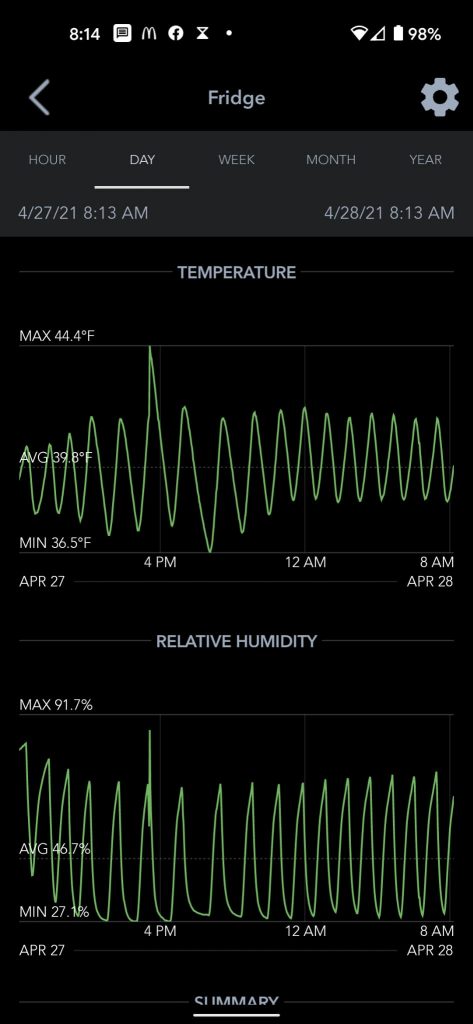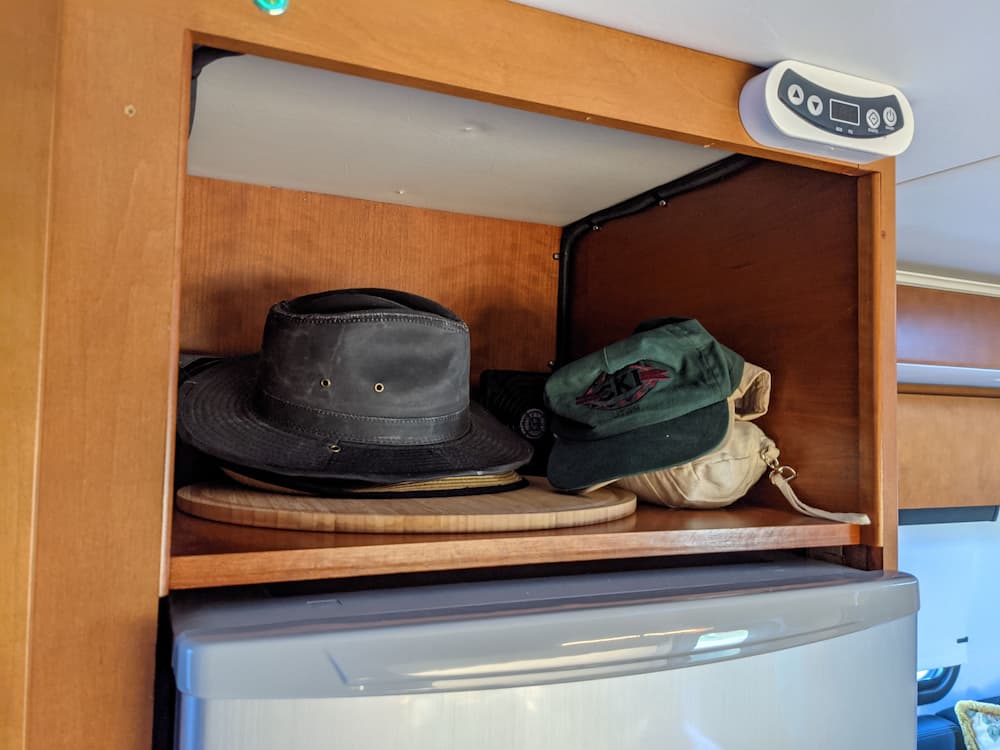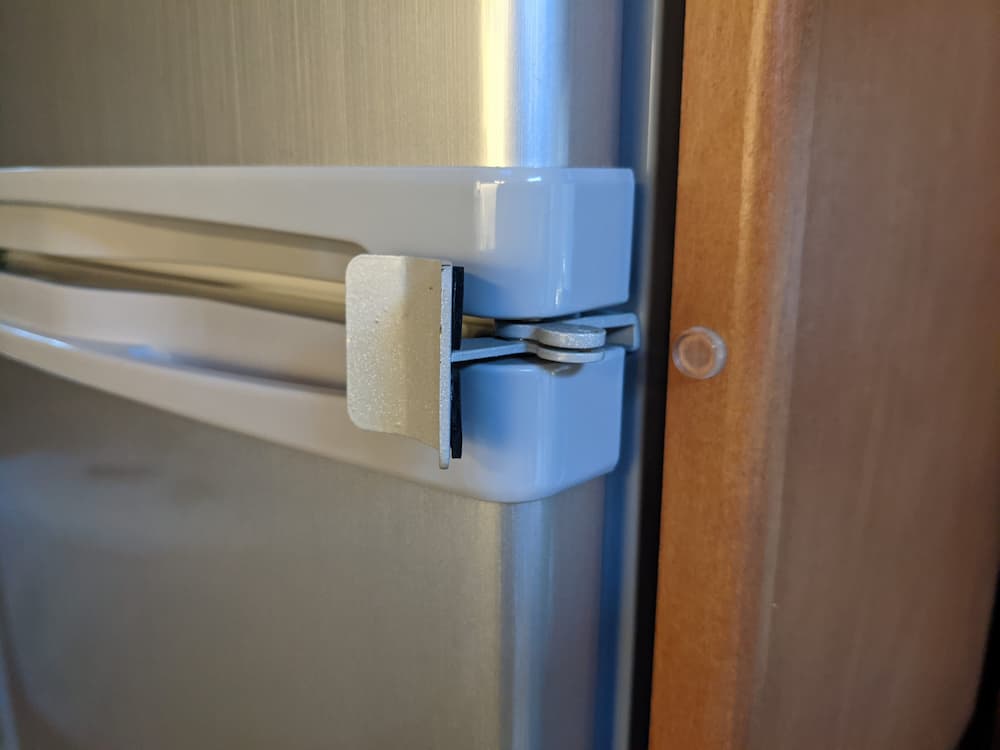Its been over a year since I installed the Isotherm Cruise 219 in my RV.
I just completed a 3 week trip out west and I thought it would be a good time to record some thoughts.
So here, in random order, is what I learned so far:
Refrigerator Drainage
I originally totally missed the importance of this during the install. The factory Dometic on my RV didn’t even have real drainage. A tiny open tray collected water on the back of the fridge. If it overflowed it went straight to the floor. However, the Dometic never drained anything anyway. When turned on it continuously accumulated frost until you turned it off, and then you stuffed towels into the fridge to avoid a flood.
This was actually one of the reasons I ditched the brand new absorption refrigerator. As bad as it was, it was obvious to me that if we ever spent a month traveling we would have to defrost it and start all over periodically.
I had originally assumed the Isotherm would be the same but hopefully not as bad. In fact much of the information I learned was from boating blogs where they discussed defrosting every few weeks.
However it turned out that the Isotherm has automatic defrost! Not in the conventional sense, but when it operates “normally” it runs approximately 50% of the time. During the “off” cycle the frost melts and pours down the back wall and out the drain, and – presto – the fridge is completely frost free.
So unlike the Dometic ,the Isotherm is constantly draining, at least until it gets really hot (more on that later).
I chose to cut off my propane line and use it for a fridge drain.

I don’t have the slightest regret about doing this! The odds of anybody ever wanting to install a propane fridge in my van are, well, zero. OK, maybe not really zero. Could somebody someday invent a super absorption fridge, thats maintenance free and works at 100 degrees? Well maybe, but I think its something like .00001% probability. In that unlikely event I could just reconnect the propane to the fitting I installed, although copper lines used for water may degrade a little, so I would probably just run a new line.
The issue is that its not a perfect drain, due to the unknown path of the propane line underneath.
When I first installed it, it passed my tests of pouring water bottles down the fridge drain. However with usage it no longer passes that test. I’m not sure if something like a small seed fell down the drain or whats going on.
However, from a practical perspective it still works. It drains slowly, but fast enough for ordinary condensation, so I haven’t yet bothered to drill a new drain hole somewhere.
On my 3 week trip there was one occasion where a few drops splattered out the front of the fridge, but they may have also simply been because we parked downhill. In that slope the fridge can’t really drain, so if you make a quick departure some is going to slop out.
For now we have been checking the back of the fridge each morning before we depart. If I was installing again I would probably drill a straight drain through the wheel well.
As an aside I do really worry about such a large drain hole and how much warm air comes back through it, and I have several mental designs for a device to close the drain while not actively draining. I may install a tiny HVAC evacuation pump with a reservoir but thats another story…
Power consumption
The Isotherm runs 5-6 amps when the compressor is operating. So if you multiply 5.5 by 24 hours, it could theoretically consume around 132 amp hours daily in extreme heat. In practice, most of us will not be RVing for pleasure in those conditions, but if you read sailboat blogs where its more likely you are out in hot and muggy conditions with no AC 24X7, that is what some people report.
In fact, I found its pretty simple to get your Isotherm to run continuously. Just set the thermostat too low as I did originally.
I found that if you set it just a bit too low, the compressor will never have enough power to reach that temp, and it just runs forever. As it runs, it rapidly accumulates frost on the rear wall in the main compartment. Since it never turns off, you have a self defeating loop of decreasing efficiency (the frost prevents full cooling) and an ever-growing frost shelf.
On my first trip I had about 1/2″ of frost by the fifth day. I had set the temperature too low, which I didn’t realize because the refrigerator was around 33 degrees inside which seemed reasonable at the time.
Later I discovered my thermostat was defective and was replaced under warranty, which contributed to this situation.
Since that repair, I have found the sweet spot for mine is about 3 3/4 on the dial. At that setting. It maintains an average temperature of 40 degrees in the very front of the fridge and the door. (We use the door for things like fruits and wine that don’t need to be as cold) Food temp in the fridge is typically in the mid to high thirties.
With AC running or in cool climates (high seventies or below) the duty cycle is somewhere around 50%.

If you look at the top graph of temperature, you can see a spike when the door is opened. The sensors just measure the air temperature at the front so the temp quickly rises. After that, it runs all night in about 30 minutes cycles, followed by 30 minutes of “off” time in 75 degree weather.
So I’m guessing that would be maybe 60 amp hours or so per day assuming a 5.5 amp draw when running.
But that said, I found that when we parked things changed. When we left the RV for 6 hours in 90 degree heat, we returned to find that it ran continuously in hot weather.
Thats not unexpected at all. These compressors are not rated for tropical conditions, and as the temperature increases the run cycle lengthens until it becomes 100%.
Oddly, I found that when I returned to 92 degree RV temperatures, the fridge was actually much colder than normal, by several degrees.
I am not exactly sure what is going on there. I don’t know if the cooling algorithm is doing that on purpose or not, but thats how mine works. Any time the RV temp got somewhere over 90 degrees the fridge ran continuously and stayed slightly colder than normal.
So that meant when we were out “adventuring” we might around 88 amp hours a day. 16 hours of a 50% run cycle, and 8 hours of a 100% run cycle.
88 amp hours daily sounds like a lot, but with 600 watts of solar and 2 lithium batteries (and alternator charging) in practice it was never an issue.
Intelligent Temperature Control (ITC)
So, we are talking about this:

At the very top of the picture is the ITC. Note that we originally intended to install a small microwave on the cherry shelf I made, but never use a microwave, so for now its a hat and purse shelf. Very handy.
But anyways the ITC is a remote control that is supposed to have a lot of features but in actuality was a disaster. From the day I installed the fridge we had nothing but problems. The fridge ran continuously, 24×7, resulting in so much frost that it was unusable for any trip over a few days.
Numerous calls and emails to Isotherm tech support ran me down numerous rabbit holes. They fixated on the frost issue. But it turns out frost is the natural side effect of running continuously.
To Isotherm’s credit, they sent me a new door, a new controller board, and probably numerous other parts I forgot about it.
I never did figure out why it didn’t run properly with the ITC. It may have simply been that I had it set too low, thus causing the run loop. Or perhaps the ITC, with its rear wall mounted thermostat, just doesn’t work well with this model.
From time to time I toy with the idea of hooking it back up, but since the fridge is working very well now and the ITC doesn’t really have any additional value other than looking cool I haven’t gotten around to it and may never.
Latch
The funniest thing about these refrigerators is that they don’t come with a latch. Instead its boxed with a five dollar child latch that went in the trash.
When I called Isotherm they recommended a moving strap. Seriously. In fact they don’t even really support the fridge if you don’t strap it closed as they just assume the door is not sealed.
If you skip the latch I can guarantee that your refrigerator door will fly open sooner or later on a turn and fill your galley with fresh food.
Luckily for me, I somehow found an Australian refrigerator that was very similar and a perfect latch! It was quite a pain to import the latch part it as they refused to sell it internationally, but I eventually was able to get my hands on one:


Now the bad news is that they don’t sell this anymore, so you are going to have to look for a universal one I’ve seen online or fashion something yourself.
Tech Support
There are two parts to Webasto/Isotherm tech support.
I emailed Italy directly, and received fast accurate answers in pretty good English. So for instance when I wanted to verify where to drill the hole in the rear of the fridge for the ITC they were very responsive.
For actual warranty work, I had to drive to South Florida / Ft. Lauderdale area.
There I found their shop which even had mobile vans for the many yachts they service there I presume.
The main problem I had there was that if the fridge turns on and works they consider it good to go, so I had to raise my voice a bit and insist they monitor it for a week.
Eventually they agreed with me that the factory thermostat was complete nonsense. (Anything less that a “6” was 55 degrees, “6” or “7” ran continuously).
Once they replaced the thermostat (and again, the Danfoss controller board, which was my third or fourth) it operated correctly for the first time since I’d owned it.
But on the whole, I’d give Tech Support at least a B+. It was out of warranty for a couple weeks by the time they finally received it, but they repaired it no-charge and its been fine since.
Fridge Monitoring
From day 1, I struggled to monitor the refrigerator. The wireless temp displays that everybody has show you what the fridge is at right now, but not the history. If you return to the RV and the fridge is a little warm its really important to know if its been that way for 10 minutes or 10 hours.
My Victron battery monitor helped a little while dry camping. And since I also have the Venus Internet monitor I could also keep an eye remotely.
But there were real limitations. With a couple fans running it wasn’t always clear if the fridge was running or not, and in in any even I couldn’t see the temperature remotely.
Eventually I stumbled on these Sensorpush Pro sensors. This completely solved the problem. They keep a 30 days running graph of the temperature, so I was always able to see at a glance whats going on.
At one point I started to install a DC current monitor on the fridge but the Sensorpush eliminated that need. From the run graph you can imply when the compressor is on.
And more importantly, know for sure that food temp is in a safe zone.
Bottom Line
It works pretty well now. A couple of times we got a bit over-confident, placing leftovers or warm food inside. We found that if you did that with small amounts you could get away it mostly, but one time we stuffed it with less-than-cold fresh groceries and it complained loudly, taking several hours to cool down.
So whenever we have an appreciable amount of not-so-cold food we precool it in our cheap Chinese compressor fridge we keep behind the drivers seat. I can load in a few bottles of warm wine and a bunch of warm veggies and fruits and put it in the main fridge once its cooled down.
Obviously at some level of heat the refrigerator will fail to maintain a safe temperature but we haven’t had that happen yet. In the low 90’s during the day and cooler at night it works just fine. We never were able to get the Dometic to work in hot weather, so that is a huge improvement.
I consider this the most important upgrade I ever made.
The super-sized 219 has worked out really well for us. Its cavernous size means we can take with us pretty much anything we want.
From the time you turn it on until the time its fully chilled is about 3-4 hours.
Lastly, if I have forgotten to mention the freezer, its because its flawless. Temperature varied from around -5 to a high of 10 degrees, averaging about 5 degrees, so food was always cold and hard. After 4 weeks of use there was no noticeable frost inside.

Thanks for your report and experiences.
Thanks for sharing. My Dometic is near death. I have a 2018 Unity Cornerbed and want to do something like this. Do you remember what the cutout size was when you removed the old unit? I see that the width of the 195 and the 22o is 21.4 Inches wide. The only difference seems to be height. If It will fit width-wise, and I need to modify the top shelf, I’m thinking I could install the 220 for a little more fridge space. It’s 60.8 inches tall.
Was the flange a problem for you?
Brian
2018 Unity CB
Hi sorry I don’t remember the exact dimensions. For the smaller 165 it definitely fits as is. For my 219 it was pretty extensive changes I had to shave down the side trim piece for clearance and then raise the top shelf.
Making brackets to hold down was not hard but I did have to think about it a while!